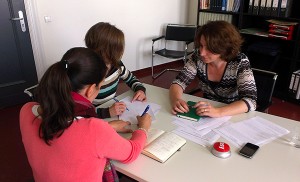A Novel – Not Just for Grown-ups
During the week of October 21 to 27, 2013 the Academy of the Jewish Museum Berlin, in cooperation with Kulturkind e.V., will host readings, workshops, and an open day for the public with the theme “Multifaceted: a book week on diversity in children’s and young adult literature.” Employees of various departments have been vigorously reading, discussing, and preparing a selection of books for the occasion. Some of these books will be introduced here over the course of the next few months.

The Hohenemser Literature Prize was recently given for the third time, an award bestowed upon German-language writers whose native language isn’t German. The call for submissions reads:
“In a convincing literary way, these writers should address not only emigrant experiences but also the intertwining of different cultural traditions and biographical influences. With a free choice of subjects, they will acknowledge the background of a continuously changing present – a present in which language, literature, and identity itself, can in no way be considered constants.”
The first prizewinner, in 2009, was Michael Stavaric, the author of Gaggalagu. This year the prize was given to Sasa Stanisic, who was born in 1978 in Bosnian Visegrad and moved to Germany in 1992 as a refugee of the civil war.
In his first published novel from the year 2006, How the Soldier Repairs the Gramophone, his hero Aleksandar Krsmanovic – “Comrade in Chief of the unfinished” – tells heart-wrenching stories full of black humor, narrated in the brightest colors, about life in Visegrad. → continue reading
Inés Garland’s Novel for Young Adults about Friendship and Love
During the week of October 21 to 27, 2013 the Academy of the Jewish Museum Berlin, in cooperation with Kulturkind e.V., will host readings, workshops, and an open day for the public with the theme “Multifaceted: a book week on diversity in children’s and young adult literature.” Employees of various departments have been vigorously reading, discussing, and preparing a selection of books for the occasion. Some of these books will be introduced here over the course of the next few months.

Why are young adult novels touching in a different way than books for adults? And why are they touching not only for young people?
Is it that the writers of stories for young adults are less embarrassed to use everything they have to elicit strong feelings in their readers?
Barring Harry Potter, I hadn’t read any young adult books since my own adolescence, until reacquiring a taste for them over the course of our reading marathon. A taste for giving myself over completely to the beautiful, tragic, comic destinies of the characters, for succumbing to a story. For example, to the story of Alma in Inés Garland’s book Piedra, papel o tijera [‘Rock, Paper or Scissors’] (in the original Spanish, or Wie ein unsichtbares Band [‘Like an Invisible Ribbon’] in the German edition): → continue reading
The Blog’s Editorial Staff in Discussion (Part II)

Meeting of the website editors
© Jewish Museum Berlin, photo: Michael Butschkau
Naomi Lubrich: We recently talked together about Eva Menasse’s novel Quasicrystals but we haven’t decided which of us will write a review of the book for our blog. Personally I would be interested in doing it, and I have something to say not only about the Jewish theme but also about Menasse’s image of women, that I found to be unrealistically and ideationally drawn. Xane is a downright caricature of a “high-powered woman”: a caring mother and stepmother of three children with, to some extent, behavioral problems. And at the same time she’s a leading film artist and influential intellectual. On top of all this she has a harmonious, uncomplicated marriage, and she even gets involved with a number of other men… → continue reading

